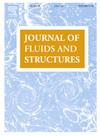Aero-acoustic-elastic flutter of plates
IF 3.5
2区 工程技术
Q1 ENGINEERING, MECHANICAL
引用次数: 0
Abstract
The linear stability of an elastic plate with supersonic freestream flow on one side and a cavity on the other is investigated for the special case when the first acoustic frequency of the cavity is close to the natural frequencies of the plate. To illustrate the effect of aero-acoustic-elastic coupling on flutter onset, a simplified three degrees-of-freedom model is derived including two structural and one dynamic acoustic pressure modes. The model is nondimensionalized to obtain three parameters that describe the acoustic-elastic coupling and one for the aerodynamic stiffness as modeled using Piston Theory aerodynamics. The role of the nondimensional parameters on flutter onset and frequency is investigated. A test case from a recent wind tunnel experiment is analyzed using the full computational model to validate the findings from the illustrative model and quantify the effect of acoustic coupling on flutter onset. A linear stability analysis predicts that the plate used in the experiments is stable at the wind tunnel conditions for cavity depth greater than 60% chordlength. For smaller cavity depth, the plate is expected to flutter as the first and second structural modes coalesce. Wall impedance is included in the analysis to investigate the effect of acoustic damping. Higher-order acoustic-elastic mode crossings are stabilized when acoustic damping is included however the two-mode flutter instability is not affected. These results suggest that the full aero-acoustic-elastic coupling must be considered for accurate prediction of flutter onset and aeroelastic behavior of elastic plates in supersonic flow. Moreover, this phenomenon can be leveraged in wind tunnel experiments to measure post-flutter responses at reduced dynamic pressures by appropriate design of the acoustic cavity.
板的气动声弹性颤振
研究了一边为超音速自由流,另一边为空腔的弹性板在空腔第一声频率接近板固有频率的特殊情况下的线性稳定性。为了说明气动-声弹性耦合对颤振发作的影响,推导了一个包含两个结构模态和一个动声压模态的简化三自由度模型。对模型进行无量纲化处理,得到描述声弹耦合的三个参数和用活塞理论空气动力学建模的一个气动刚度参数。研究了无量纲参数对颤振发作和颤振频率的影响。利用完整计算模型分析了最近风洞试验的一个测试案例,验证了说明性模型的结果,并量化了声耦合对颤振发作的影响。线性稳定性分析表明,在腔深大于60%弦长的风洞条件下,实验用板是稳定的。对于较小的空腔深度,当第一和第二结构模态合并时,预计板将发生颤振。在分析中考虑了壁阻抗,研究了声阻尼的影响。考虑声阻尼时,高阶声弹性模态交叉是稳定的,而双模态颤振不受影响。这些结果表明,为了准确预测弹性板在超声速流动中的颤振发作和气动弹性行为,必须考虑充分的气动-声-弹耦合。此外,这一现象可以在风洞实验中利用,通过适当设计声腔来测量在降低动压下的颤振后响应。
本文章由计算机程序翻译,如有差异,请以英文原文为准。
求助全文
约1分钟内获得全文
求助全文
来源期刊

Journal of Fluids and Structures
工程技术-工程:机械
CiteScore
6.90
自引率
8.30%
发文量
173
审稿时长
65 days
期刊介绍:
The Journal of Fluids and Structures serves as a focal point and a forum for the exchange of ideas, for the many kinds of specialists and practitioners concerned with fluid–structure interactions and the dynamics of systems related thereto, in any field. One of its aims is to foster the cross–fertilization of ideas, methods and techniques in the various disciplines involved.
The journal publishes papers that present original and significant contributions on all aspects of the mechanical interactions between fluids and solids, regardless of scale.
 求助内容:
求助内容: 应助结果提醒方式:
应助结果提醒方式:


